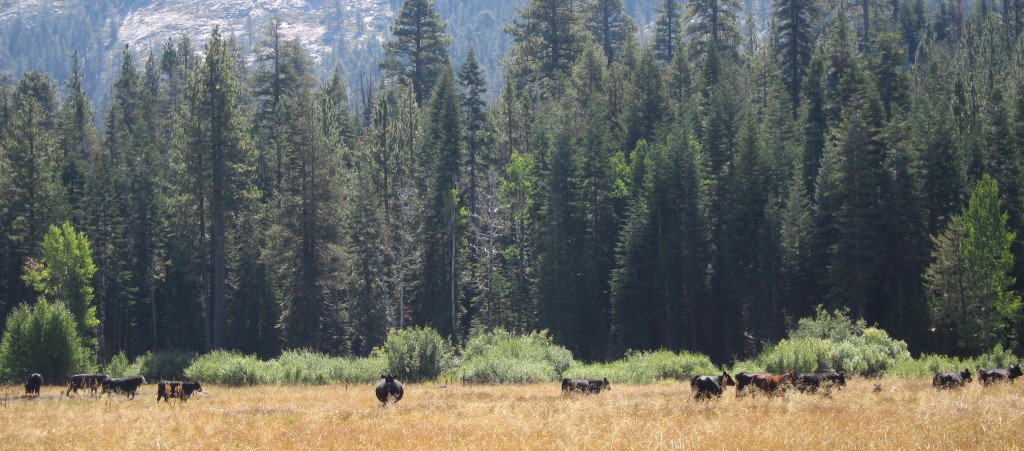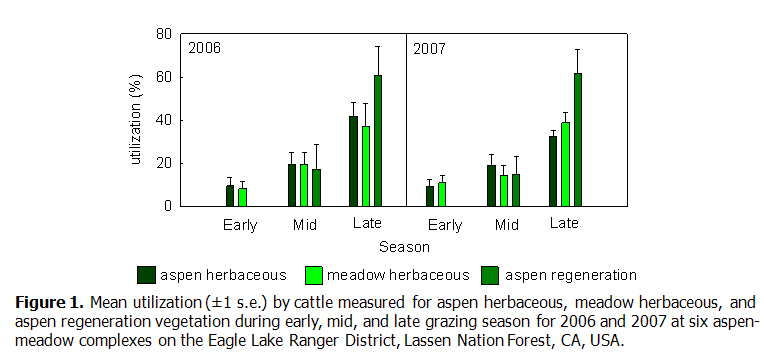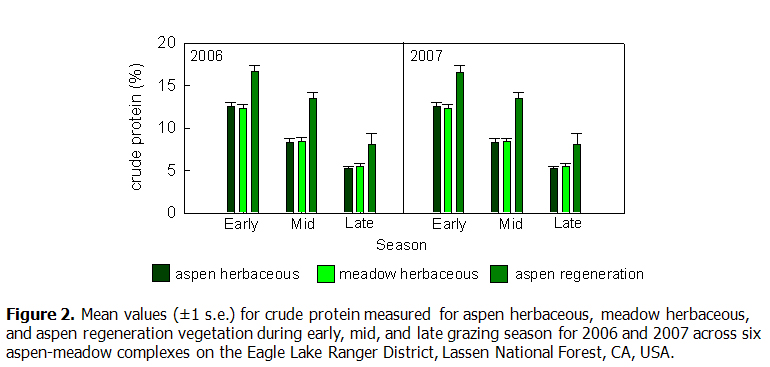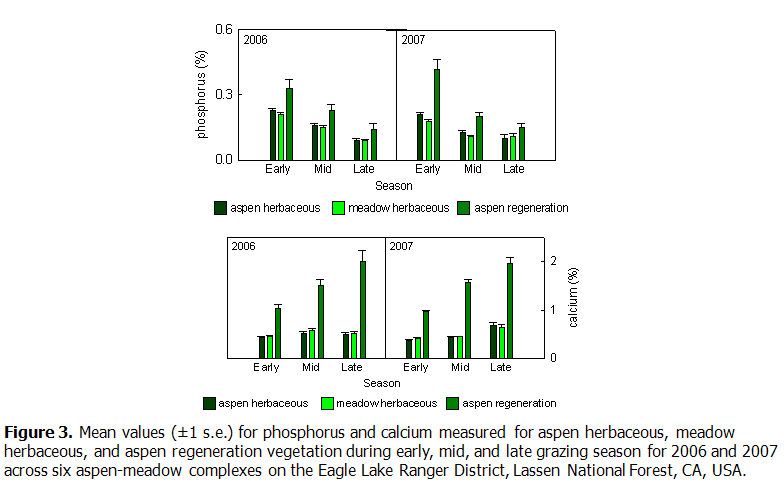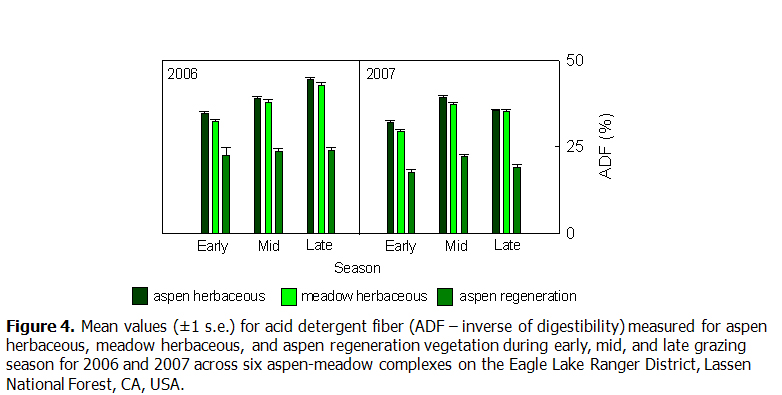Aspen restoration in grazed landscapes is a priority for many resource managers. Stand protection practices such as exclusionary fencing are often recommended where browsing is suppressing aspen regeneration. However, wide-spread exclusionary fencing of stands may not be ecologically or economically practical. For example, on Eagle Lake Ranger District Lassen National Forest (ELRD LNF), over 250 aspen stands need protection from excessive cattle browse. Management of season, intensity, and frequency of browse is an alternative to exclusionary fencing to restore aspen.
Grazing management strategies must also be designed to account for seasonal forage quantity and quality differentials between aspen regeneration and other available forage types (i.e., meadow and aspen understory herbaceous vegetation). We conducted two studies in aspen stands within cattle grazing allotments on the ELRD LNF between 2003 and 2007 to examine grazing management and aspen restoration options.
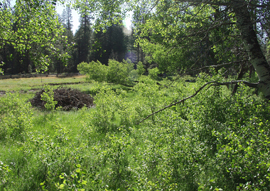
Simulated Browsing Experiment
The objective of this study was to examine the effects of intensity and season of browsing on annual height growth of aspen suckers. The goal was to aid development of livestock grazing strategies to restore stands in decline due to excessive livestock browsing. In particular by providing guidance on aspen recruitment response to annual browse utilization. We implemented 33 combinations of intensity and season of browse on aspen suckers in three aspen stands on Eagle Lake Range District, Lassen National Forest, CA, USA during 2003 and 2004.
Key Results
-
Greatest growth was on suckers with no terminal leader browse and ≤ 25% of biomass removed from branches. Lowest growth occurred when 90% of terminal leader length and 50% of branches biomass was removed.
-
Growth was most negatively affected by browse on terminal leader.
-
Growth was lowest for suckers browsed mid-season only and suckers browsed both early and mid-season.
-
Occurrence of conifer in the stand overstory significantly reduced sucker growth.
-
Managers should minimize: browse on terminal leaders; mid-season browse over consecutive years; and repeated browse during a growing season.
Management Implications
Several factors are driving aspen declines across western North America. Where excessive livestock grazing is contributing to stand decline, protection of suckers from browse is a critical component of aspen restoration. Fencing stands can eliminate livestock browsing, and is a good option for extremely degraded stands at risk of extinction. Across the broader landscape, managers can use grazing practices such as herding-water-supplement distribution activities, rest-rotation systems, and seasonal grazing strategies to actively manage the season, intensity, and frequency of browse on aspen suckers. Intensity of terminal leader browse is a major determinant of annual aspen height growth, and should serve as a monitoring indicator for making livestock management decisions to enhance aspen regeneration. A key management goal should be to minimize browse on sucker terminal leaders. Suckers with ≤ 20% of terminal leader growth removed averaged over 50% of height growth observed on non-browsed control suckers, and should grow above the browse line within several years. Mid-season browse should be avoided over consecutive years. Intensity of terminal leader browse should be minimized during mid and late season. Repeat browsing of suckers within a growing season should be avoided. Evidence of repeat browsing should be a signal to managers to adjust grazing management, primarily the amount of time livestock have access to a stand.
Related Publication: Jones, B.E., D.F. Lile, K.W. Tate. 2009. Effect of simulated browsing on aspen regeneration: implication for restoration. Rangeland Ecology and Management 62:557-563. Read more.
Cattle Selection for Aspen and Meadow Vegetation
Understanding seasonal dynamics of biomass, quality, and utilization of forage types found in aspen-meadow complexes can provide insight in developing cattle grazing strategies to restore aspen stands. Our objectives in this study were to quantify seasonal differences in: 1) forage quality among meadow herbaceous vegetation, aspen understory herbaceous vegetation, and aspen regeneration, 2) biomass of meadow herbaceous vegetation and aspen understory herbaceous vegetation, and 3) utilization of meadow herbaceous vegetation, aspen understory herbaceous vegetation, and aspen regeneration by cattle. We evaluated seasonal biomass, forage quality, and utilization by cattle of aspen regeneration, aspen herbaceous understory vegetation, and meadow vegetation found within six aspen-meadow complexes in 2006 and 2007.
Key Results:
-
Early season foraging by cattle focused on meadow and aspen understory vegetation (Fig. 1).
-
Mid-season decreases in meadow and aspen understory forage quality coincided with an increase in aspen regeneration utilization (Fig. 1 - 4).
-
By late growing season, utilization on aspen regeneration was significantly greater than aspen understory or meadow vegetation (Fig. 1).
-
Aspen regeneration had greater forage quality compared to aspen understory and meadow vegetation regardless of season or year (Fig. 2 -4).
-
Forage quality declined with season in all three vegetation types (Fig. 2 - 4).
Management Implications:
Seasonal utilization of different forage types by cattle is a function of relative forage quantity, forage quality, and cow nutrient demand. Managers must consider all three aspects when developing seasonal grazing strategies for meadows and adjacent aspen communities. A clear grazing management goal for the restoration of aspen must be to limit defoliation intensity on aspen regeneration mid and late growing season. The challenge presented to the manager by the increasing forage quality differential between aspen regeneration and herbaceous vegetation as the annual growing season progresses is significant. The cow’s preference will always turn to aspen as the season progresses. Season of grazing should be managed annually to insure that mid and late season use does not occur in consecutive years. Early season only grazing in management units with aspen essentially creates rest from grazing for aspen stands, due to low cow preference for aspen during this period. Season of use and rest from grazing can be managed via rotational grazing strategies such as rest rotation. It is also important to set stocking rates such that herbaceous forage quantity is not limiting, which potentially increases utilization of aspen. Annual variation in precipitation and forage production must be accounted for in grazing strategies, with attention paid to low herbaceous forage production years when use of aspen could occur earlier in the growing season, compared to wetter years. Finally, it is important that managers provide nutritional supplements to insure that a source of protein and other essential nutrients is available to cattle, as opposed to aspen serving as a supplement source.
Related Publication: Jones, B.E., D.F. Lile, K.W. Tate. 2011. Cattle selection for aspen and meadow vegetation: implications for restoration. Rangeland Ecology and Management 64:625-632. Read more.

